How Geo Push Notifications Work: Best Practices + Examples
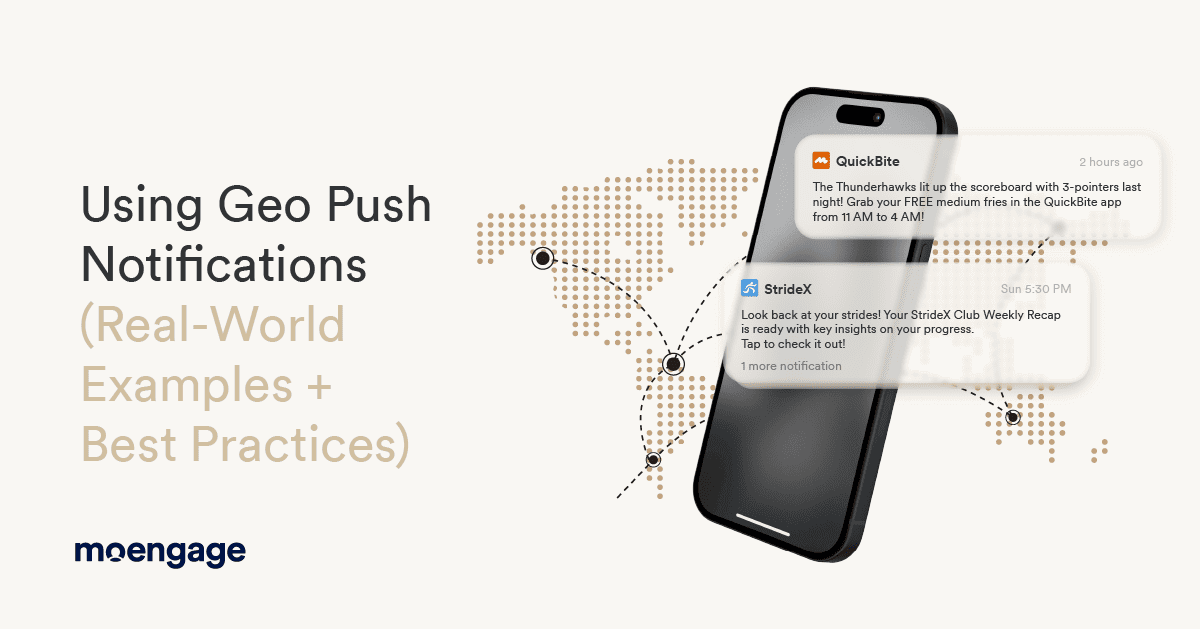
The phrase “being at the right place at the right time” doesn’t just imply a stroke of luck – it’s a strategic advantage that geo push notifications can provide. This powerful tactic can put you ahead of the competition and ensure your messages reach your customers when they are most likely to act.
The digital world is more crowded today than ever. Consumers keep getting bombarded with messages, ads, SMS, and much more through mobile and web push notifications – all vying for customer attention. In this chaos, relevance isn’t just important; it’s everything.
Geo-targeting changes the game here. By leveraging your customers’ real-time location data, your brand can deliver a hyper-personalized experience that reaches customers at the right moment.
Let’s dive deeper into how you can implement location-based push notifications for your brand.
What Are Geo Push Notifications?
Geo push or geo-targeted push notifications, also known as location-based push notifications, use GPS, Wi-Fi, Bluetooth, or IP data to deliver real-time messages when customers enter, exit, or stay in a specific area. Brands use them to send personalized offers, alerts, or updates at the right time, increasing engagement and conversions.
For example, imagine a customer entering a mall’s parking lot and instantly being shown a vacant spot. Or an avid shopper being offered a discount as soon as they enter a store. Whether a special offer or a timely update, geotargeting ensures messages aren’t just seen, but acted upon.
How to Geo-Target Your Push Notifications
Brands can set up geo push notifications across Android and iOS devices (with customers who’ve agreed to share their data on iOS). The key is to balance relevance, timing, and user privacy to create a positive experience that drives results.
Here are a few tips before you set up geo-targeting for your brand:
- Start by defining your virtual boundaries for precise targeting
- Obtain the user’s permission for location data access
- Only deploy context-driven content; don’t abuse the opportunity
- Put a frequency capping on your system to avoid overwhelming customers
- Implement robust data protection measures for lasting engagement
Suppose Starbucks notices a frequent visitor passing by a Starbucks café in a different region or locality. With geo-targeting, they can instantly send them a mobile push notification, saying — “Missing your favorite latte? We’re just 100 meters away!”
Now, to make this happen, the most common ways brands can explore are:
1. Beacons
Beacons are small Bluetooth devices that broadcast signals to nearby smartphones. When a customer’s device comes within the range of a beacon, it can trigger geo push notifications.
The ideal use case for a beacon is an indoor space, since it can accurately detect proximity up to 10 meters. For instance, Adidas could send customers entering the store a quick push notification on its iconic or best-seller items.
2. Geofencing
Geofencing creates a virtual boundary around a specific geographic area using GPS or RFID (Radio Frequency Identification) technology.
When a customer enters or exits a specific location, a push notification is triggered. This method offers flexibility in targeting and is easier to implement at scale than beacons, as it doesn’t require physical hardware installation.
McDonald’s can use geofencing to send time-sensitive offers around stores in a certain region, driving foot traffic and increasing sales.
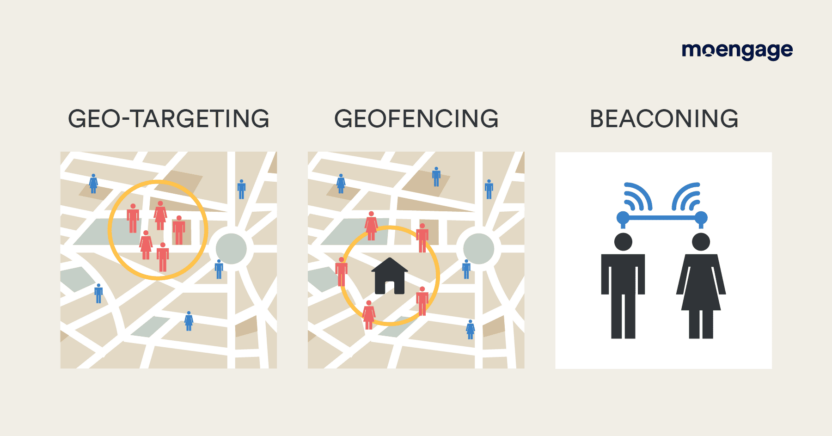
3. Wi-Fi or network-based targeting
You may have noticed that certain brands can reach you as customers when you sign up for public or private Wi-Fi in specific locations, such as train stations, airports, clinics, or malls.
Wi-Fi usage tells marketers that the device owner is in that location, making it easier to target them. Brands can get creative with the content and create a solid experience here.
Imagine McDonald’s using wordplay through this banner, asking customers if they have had their fries yet.
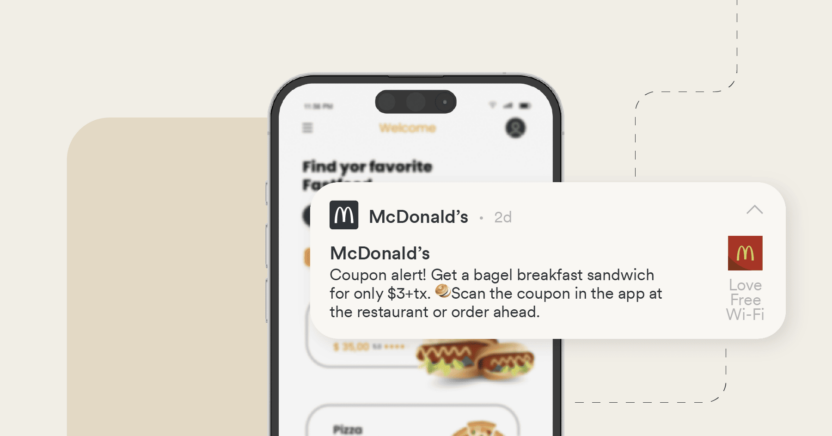
5 Benefits of Location-Based Push Notifications
The United States will spend $455.90 billion on ads in 2025. Where do you think that money is going? Building brand value, achieving an uninterrupted mind share amongst their customers, and more.
It may be difficult for smaller brands to fathom such amounts. Still, more brilliant tactics, like geo push notifications, can help them stay ahead of the curve and use technology with a pinch of creativity to boost conversions.
Here’s how geo-targeting can enhance customer experience, drive conversion, and build a stronger relationship with customers:
1. Improved engagement rates
The increased demand for effective marketing has driven the need for location-based campaigns, ensuring that the location-based marketing market will reach $232.7 billion by 2032.
The growth comes from marketers’ strong belief in improved conversion and boosted customer engagement, since customers are more likely to respond to push notifications that are relevant to them at that moment.
Remember, you need to track the right push notification metrics to gauge their performance within a certain time period.
2. Personalized customer experience
Geo-targeted messages nearly doubled open rates from 4.2% to 7.9% and more than doubled conversion rates from 1.5% to 3.8%, making them far more effective than generic notifications. This is primarily driven by personalizing the content to a T and making it incredibly contextual.
3. Competitive edge
Leveraging location-based push notifications allows brands to stay ahead of the curve. By delivering timely and contextual content, brands can increase brand recall, engagement, and conversions, thus setting themselves apart from competitors.
4. Improved ROI on marketing spends
With precise targeting, brands reduce wasted ad spend and focus on customers more likely to convert. It increases the efficiency of marketing campaigns, as brands only send push notifications to customers in the right location to take action.
5. Better customer retention
Customer retention rates increase by 5% for every 1% increase in customer satisfaction, which is an opportunity for geo-targeting to empower brands. Geo push notifications help build engagement and create meaningful interactions with customers.
Examples of Location-Based Push Notifications to Learn From
-
Starbucks
Here’s some motivation for you to use personalized customer experiences for greater engagement!
Starbucks is known for juicing out location-based marketing to drive footfall. Using geofencing, the brand sends promotion offers to regular customers tailored to their preferences and past order history.
In this example, the brand has used personalization to a T – which would instantly drive customers to their café and place an order.
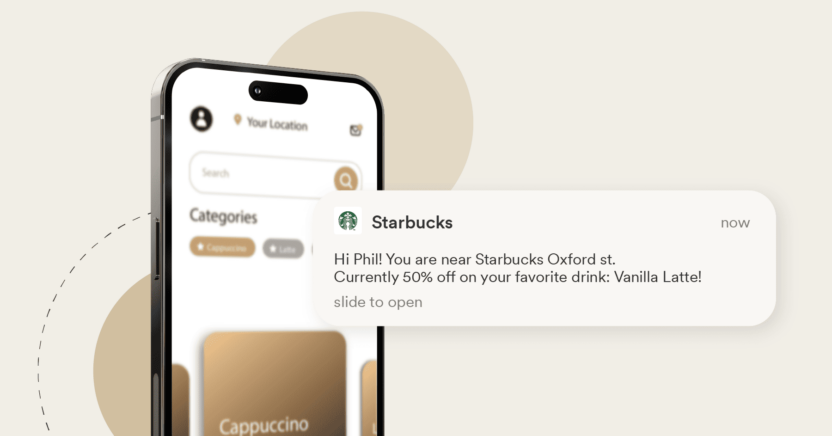
-
Foursquare
A location-based social networking app, Foursquare uses location as an opportunity to connect customers with brands, offers, and places they’d like to visit.
The notification below is sent to customers upon detecting their proximity to New York City. Due to its timely nudge, customers can easily navigate, shortlist, and bookmark places ahead of their trip to New York for a seamless experience.
“🚀 If you’re heading to New York, you should save these places to your must-see list!”
-
Uber
By 2028, smartphone mobile network subscriptions will exceed 7.7 billion, each with the ability to map device locations. As a brand, Uber has used this information to create a lasting experience for its customers.
Imagine you’ve just landed in Vienna. As you start thinking of ways to reach your destination on time, Uber prompts you to book a cab from the airport—voilà!
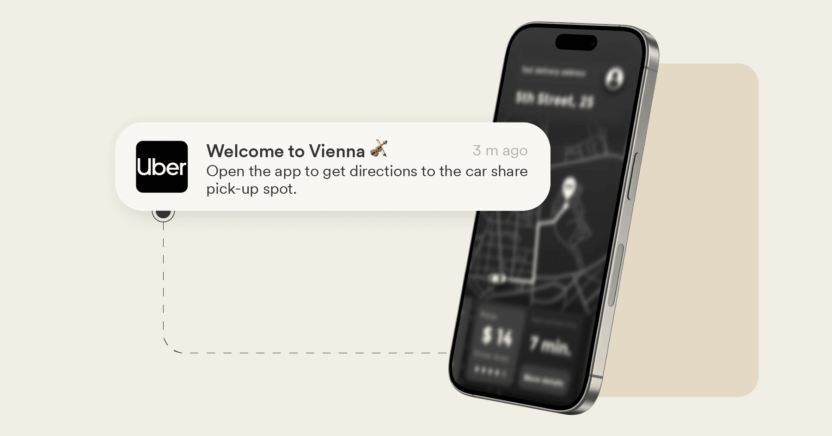
Such prompts save customers the hassle of searching the app themselves for discounts, directions, and more – everything is now served on a silver platter.
Are you keen to get creative? Explore more push notification examples.
How to Optimize Your Geo Push Notifications for the Best Results
We can’t emphasize enough how geo-targeting is helping brands stay relevant in this fast-paced digital world. That said, optimizing your content strategically to maximize its effectiveness is always the best approach.
Here are four best practices to ensure your location-based push notifications drive higher engagement:
1. Leverage geo-fencing for precision targeting
While it may limit your reach, most brands can optimize their messaging based on the user’s location for maximum output. It ensures that messages are timely, prompt, and contextually relevant.
For example, ZARA could use geofencing to connect with frequent shoppers by reminding them about ‘frequently-browsed items’ or ‘in-cart items’ at its stores.
To increase conversions, the brand could prompt customers to check out those items in person or urge them to try those on to increase conversions.
2. Optimize geo push notifications for personalization
95% of marketers have vouched that personalization helps them win at marketing campaigns. When you mix geo-targeting with personalization, brands can offer exclusivity and relevancy in one go.
For example, fitness brands and apps can track customers’ workouts, such as morning runs or gym visits, to send out a motivational push notification. Going for a run on a popular running track or visiting a city’s workout hub can also trigger these notifications.
“Ready to crush your morning run, Alex? Your 5K streak is on fire! Lace-up and keep the momentum going. 🚀”
3. Working on frequency and timing
Marketers must balance trends with user experience. Too many push notifications at once lead to opt-outs and uninstalls. Instead, use data to optimize timing—for example, send a lunch deal at 11:30 a.m., not 3 p.m. Frequency capping is essential to avoid overwhelming users and ensure engagement.
| Pro tip: Review campaign data to identify the best days and times for engagement. A/B test messages to optimize open rates and add time-sensitive offers to build a sense of urgency. |
4. Always remain transparent
Customer trust is key to the longevity of a campaign or any other communication a brand sends. Therefore, abusing the opportunity may lead to resentment among your buyers.
Explain why you’re requesting location access and how it will enhance the user experience. Instead of forcing the content on them, let the customer opt in for the experience. When users understand the value they receive, they are more likely to keep notifications enabled and engage with them.
Here’s a neat example on iOS: The SkyCast app is seeking permission to update customers about weather forecasts based on their location.
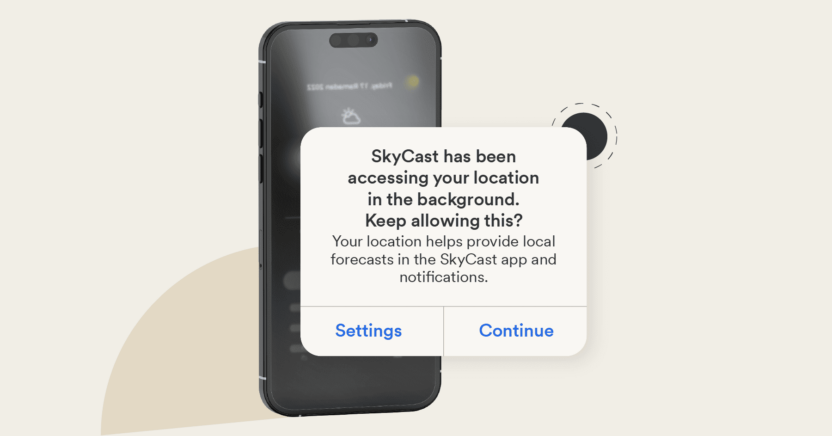
Succeeding with Location-Based Push Notifications: Conclusion
Personalization drives marketing across sectors and devices; and that’s why geo push notifications are key. Brands that effectively leverage data for personalization can capture customer loyalty, foster a more substantial relationship, and optimize their marketing spend.
And one of the platforms that can help you deliver personalized, omni-channel experiences to drive retention and business growth is MoEngage. From seamless automation to AI-driven insights, we’ve got everything you need to engage and convert your customers.
So, want to see how geo-targeting can drive more effective results for your business? Sign up for your free demo with MoEngage today.














